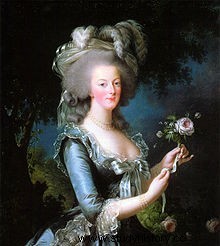Marie Antoinette of Austria is Archduchess of Austria, Princess Imperial, Princess Royal of Hungary and Bohemia, Dauphine of France, Queen of France and Navarre. Died guillotined in 1793, she was very badly perceived during her lifetime and remains a controversial personality.
Bride by proxy

Born November 2, 1755, Marie-Antoinette was the child of German Emperor Francis I st of Lorraine and the Archduchess of Austria, Queen of Hungary and Bohemia Marie-Thérèse known as "the Great .
She receives a typically female education, learning dance, posture, music, no political instruction.
On April 19, 1770, at age 14, Marie-Antoinette was married by proxy to the Dauphin of France, the future Louis XVI. Two days later, she left Vienna never to return, and this departure was painful. On May 16, 1770, she officially married the dauphin at Versailles. That day, part of the nobility already began to call her "the Austrian" and to reproach her for the change of alliance of King Louis XV made concrete by this marriage. Marie-Antoinette finds her new life difficult to bear, with court intrigues, ceremonial and lack of intimacy.
“The Austrian”
On May 10, 1774, Louis XV died and Marie-Antoinette became Queen of France at the age of 18. She has no heir (the marriage will take 7 years to be consummated) and, considered as a foreigner, becomes the target of hostilities:songs, pamphlets, pornographic texts... She is accused of being unfaithful and a nymphomaniac, of squandering public money or further the interests of Austria.
Marie-Antoinette has only a limited political role and her influence is rather cultural. It organizes parties and receptions which contribute to the influence of French fashion and commerce; it granted its protection to musicians and reawakened musical life in Versailles.
The French Revolution
Marie-Antoinette has four children, only one of whom reaches adulthood. She was particularly saddened by the loss of her daughter Sophie-Béatrice, who died in 1787 at the age of 11 months.
In 1789, when the Estates General opened, when the hatred of the people towards the queen in particular was at its height, Marie-Antoinette tried to convince her husband to leave Versailles. The famous line attributed to him concerning the brioche seems to be more of a myth than a reality. On June 20, 1791, the king and queen tried to escape but were arrested the next morning in Varennes.
In December 1792, the trial of the king began. Death was voted on December 26 and Louis XVI was executed in January 1793. In October 1793, Marie-Antoinette appeared before the revolutionary tribunal. He is accused, among other things, of collusion with foreign countries, incest, high treason. If the file against her does not contain any evidence, she corresponded at the time with Count Hans Axel de Fersen about a war prepared by Austria and the monarchies of Europe against France.
The death sentence for high treason was pronounced on October 16, 1793. It was carried out the same day and showed, according to witnesses, courage and dignity. His last words would have been to apologize to his executioner.
